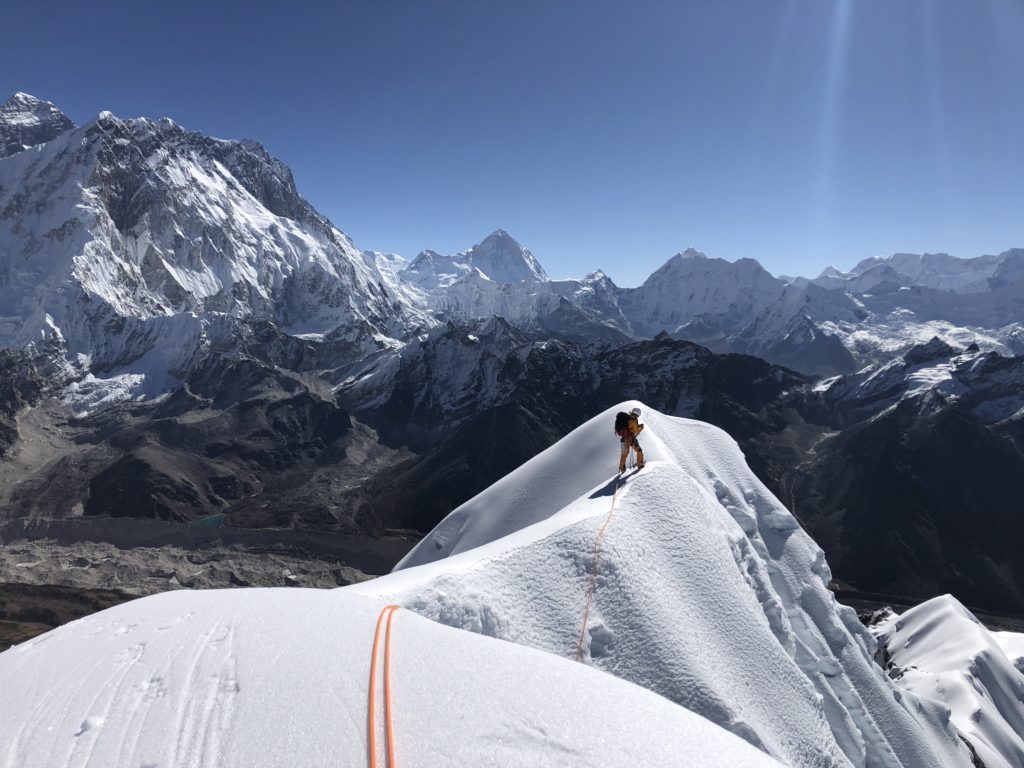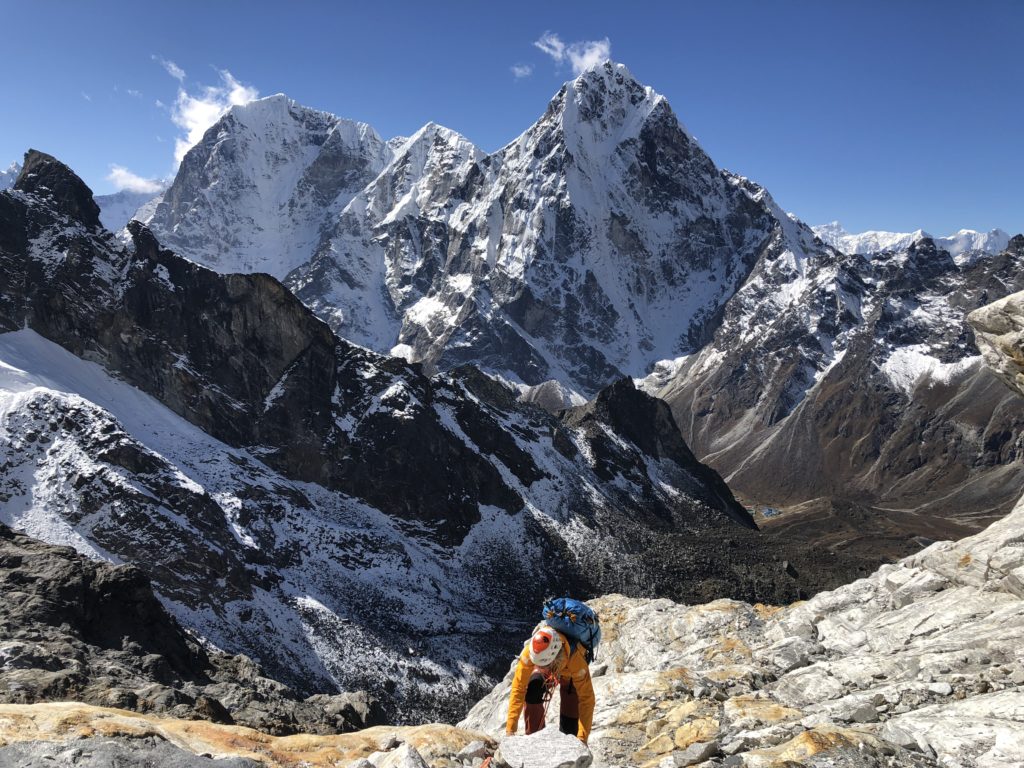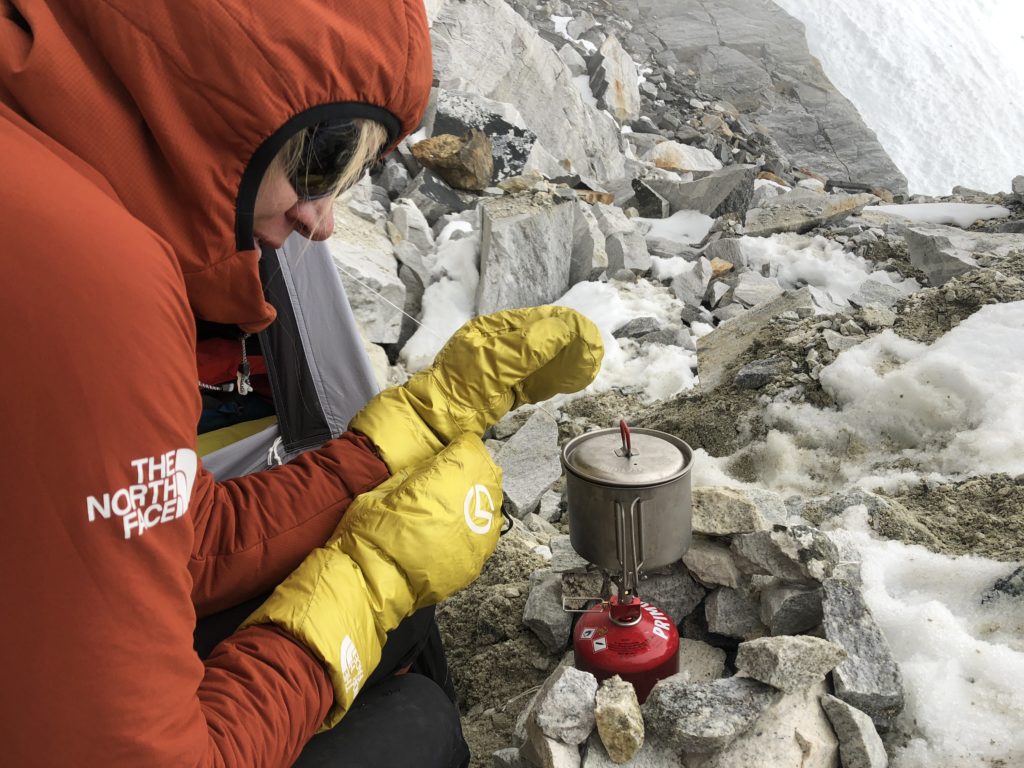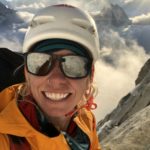Climbing in the Khumbu
Words by Sammy Podhurst
Photos by Sammy Podhurst and Anna Pfaff
Climbing in the Himalaya is interesting. There are many layers to the equation here. The acclimatization period requires patience. The lack of resources requires a lot of forethought and pre-planning. There is little infrastructure as far as rescue and medical goes. But at the same time, all of that is also what makes climbing here so alluring – the ‘wild west’ sense of it all.
I embarked on my first climbing experience in the Himalayan Khumbu region of Nepal this past fall. It was awe-inspiring, breathtaking and very different from anywhere I’d ever been. I took a great deal of learnings from this trip—both on the logistical side of things, as well as on the interpersonal side. Here are some after-thoughts I would like to share.

You need every adventure skill
You need to have all the skills before setting out into the mountains here. Climbing, rope skills, advanced technical systems, weather, snowpack, medical, route-finding, and an overall high-level of street-smarts. You don’t know what you will encounter as far as the routes go. These mountains are constantly changing, depending on the weather and snow conditions. For example, snow climbs can become steeper or the ice can be rotten, preventing good protection.
You must be capable of bailing
Bailing is a very important skill, as there is little for outside rescue resources. By the time you use an emergency communication device (i.e. InReach or Spot), it might already be too late. You need to know how to get off the mountain in case of emergency, like dangerous weather, poor conditions, or altitude sickness-related problems.
Speed is your friend
Not only do you need to have a technically skilled and creative mind, but fitness and speed are your friends. You need to be able to move fast and steady. The faster you move, the less time you spend at altitude, and the better you will fare in the overall outcome of the climb.
Information-gathering is up to you
There are no avalanche forecast centers or facilities that help climbing parties forecast hazard and stability, or that collect changing conditions and weather factors. You are on your own as far as information-gathering and assessment goes. You can hire your own weather forecaster. This is something we did (and many parties do). He was located in the states and would email us updates upon request. However, you really feel on your own. It is a big, wild place. And the information that is available to you as far as routes go, is challenging to gather. It requires you to be savvy in the investigative department.
You must be adaptable
Unfortunately, the Himalaya had a very big monsoonal season just prior to our arrival—one of the biggest in years—and our original climbing objective was not in during our time there. The snow was very sugary and unsettled on northerly aspects. It would have been a weeks-long waiting game, and even then maybe not possible. For an attempt to be made on such a route, it needs to be in good condition. The risk of overhead hazard—i.e. spindrifts hitting you while climbing, slabs ripping out from above you—would make it too dangerous. Not only that, you might be post-holing for days.
Perhaps more so than any other type of climbing, there’s high likelihood that things will not go as planned. You have to be flexible and patient. You must adopt an almost empathetic take to the mountains, and understand that they are “not always ready” for you. The mountains will always be there. You can go back when they are ready.

Over my years of climbing, I’ve learned a few things that make up the pillars that support every mountaineer and alpinist:
Fitness
Go in fitter than you think you must be. The last thing you want is to struggle with your fitness while you’re focusing on technical climbing and route-finding. Also, packs feel heavier at altitude—train with a weighted pack!
Partner
Make sure you trust your partner’s skills and mountain sense. Make sure that if you get into trouble or physically or mentally, they can bail you out. Also, make sure you can spend a lot of tent-time together.

Gear
This is an important one. Alpine climbing is a gear-intensive sport. You need equipment that is both reliable and lightweight. This is something I recommend not cutting corners on. Below are some of the key pieces of equipment that I rely solely on MSR for.
-
- DynaLock Ascent Carbon Poles: Trekking poles are such an important piece of the equation. They need to be light, yet sturdy enough to be knocked around in the rocky environment that makes up this area. You don’t typically bring extra equipment (like an additional pair of trekking poles), so you need to be able to rely on the ones you have. Overall consensus: light, yet very sturdy. Pack down very small.
- Reactor Stove System: It claims to be the, “world’s most fuel-efficient all-condition stove system.” And that’s true. It is efficient at burning fuel, and very good at preventing the wind from putting out the flame. We took the 1.7 pot, which was a good choice for melting larger quantities of snow for water and cooking meals for two at the same time.
- PocketRocket 2 Stove: This is the go-everywhere, do-everything stove. It is small enough to throw in your pack on super long hikes, and even works well high up on the mountain with enough of a wind block. It’s simple and reliably built. Enough said.
- Responder Snow Science & Rescue Shovel: Having a durable shovel to help build platforms for sleeping on the mountain is important. These shovels were work-horses—moving snow, dirt and rocks well.
 Sammy Podhurst is a mountain guide in the ski, rock and alpine disciplines. She has been working for Aspen Expeditions Worldwide, located in Colorado, for the past 10 years. Her certifications include AMGA (American Mountain Guides Association) Apprentice Ski & Alpine guide, and Aspirant Rock. She is also an AIARE (American Institute for Avalanche Research & Education) 1 + 2 Course Leader.
Sammy Podhurst is a mountain guide in the ski, rock and alpine disciplines. She has been working for Aspen Expeditions Worldwide, located in Colorado, for the past 10 years. Her certifications include AMGA (American Mountain Guides Association) Apprentice Ski & Alpine guide, and Aspirant Rock. She is also an AIARE (American Institute for Avalanche Research & Education) 1 + 2 Course Leader.
